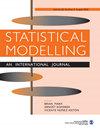A model for space-time threshold exceedances with an application to extreme rainfall
IF 1.2
4区 数学
Q2 STATISTICS & PROBABILITY
引用次数: 1
Abstract
In extreme value studies, models for observations exceeding a fixed high threshold have the advantage of exploiting the available extremal information while avoiding bias from low values. In the context of space-time data, the challenge is to develop models for threshold exceedances that account for both spatial and temporal dependence. We address this issue through a modelling approach that embeds spatial dependence within a time series formulation. The model allows for different forms of limiting dependence in the spatial and temporal domains as the threshold level increases. In particular, temporal asymptotic independence is assumed, as this is often supported by empirical evidence, especially in environmental applications, while both asymptotic dependence and asymptotic independence are considered for the spatial domain. Inference from the observed exceedances is carried out through a combination of pairwise likelihood and a censoring mechanism. For those model specifications for which direct maximization of the censored pairwise likelihood is unfeasible, we propose an indirect inference procedure which leads to satisfactory results in a simulation study. The approach is applied to a dataset of rainfall amounts recorded over a set of weather stations in the North Brabant province of the Netherlands. The application shows that the range of extremal patterns that the model can cover is wide and that it has a competitive performance with respect to an alternative existing model for space-time threshold exceedances.时空阈值超越模型及其在极端降雨中的应用
在极值研究中,观测值超过固定高阈值的模型具有利用可用极值信息同时避免低值偏差的优势。在时空数据的背景下,挑战在于开发考虑空间和时间依赖性的阈值超出的模型。我们通过在时间序列公式中嵌入空间依赖性的建模方法来解决这个问题。随着阈值水平的增加,该模型允许在空间和时间域中出现不同形式的限制依赖。特别是,假设时间渐近独立,因为这经常得到经验证据的支持,特别是在环境应用中,而空间域的渐近依赖性和渐近独立性都被考虑。通过配对似然和审查机制的组合,对观察到的异常进行推断。对于那些删节两两似然的直接最大化是不可行的模型规范,我们提出了一个间接推理程序,在模拟研究中得到了令人满意的结果。该方法应用于荷兰北布拉班特省一组气象站记录的降雨量数据集。应用表明,该模型可以覆盖的极值模式范围很广,并且相对于替代的现有时空阈值超越模型具有竞争性能。
本文章由计算机程序翻译,如有差异,请以英文原文为准。
求助全文
约1分钟内获得全文
求助全文
来源期刊

Statistical Modelling
数学-统计学与概率论
CiteScore
2.20
自引率
0.00%
发文量
16
审稿时长
>12 weeks
期刊介绍:
The primary aim of the journal is to publish original and high-quality articles that recognize statistical modelling as the general framework for the application of statistical ideas. Submissions must reflect important developments, extensions, and applications in statistical modelling. The journal also encourages submissions that describe scientifically interesting, complex or novel statistical modelling aspects from a wide diversity of disciplines, and submissions that embrace the diversity of applied statistical modelling.
 求助内容:
求助内容: 应助结果提醒方式:
应助结果提醒方式:


